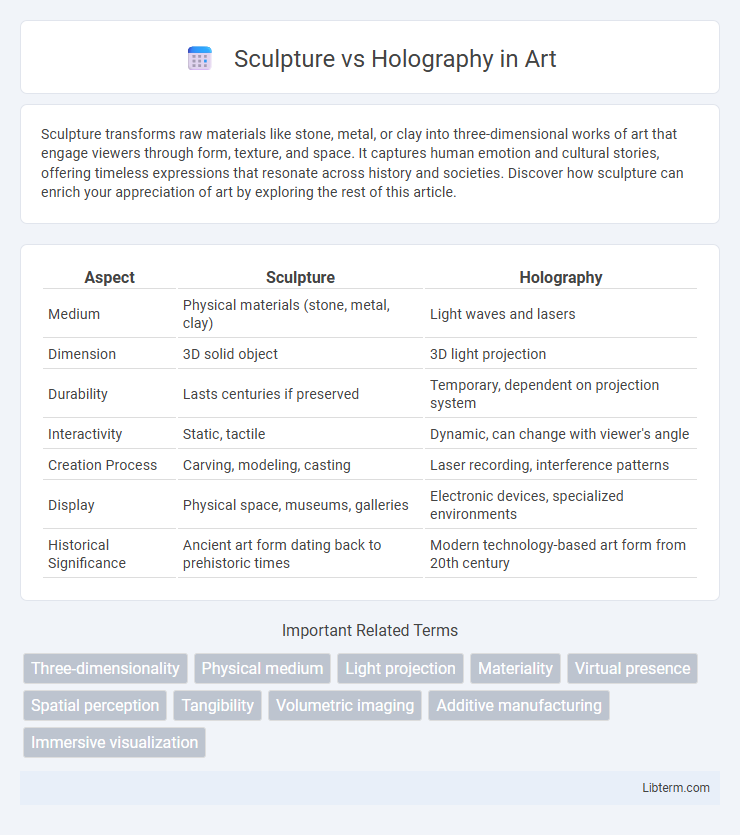Sculpture transforms raw materials like stone, metal, or clay into three-dimensional works of art that engage viewers through form, texture, and space. It captures human emotion and cultural stories, offering timeless expressions that resonate across history and societies. Discover how sculpture can enrich your appreciation of art by exploring the rest of this article.
Table of Comparison
| Aspect | Sculpture | Holography |
|---|---|---|
| Medium | Physical materials (stone, metal, clay) | Light waves and lasers |
| Dimension | 3D solid object | 3D light projection |
| Durability | Lasts centuries if preserved | Temporary, dependent on projection system |
| Interactivity | Static, tactile | Dynamic, can change with viewer's angle |
| Creation Process | Carving, modeling, casting | Laser recording, interference patterns |
| Display | Physical space, museums, galleries | Electronic devices, specialized environments |
| Historical Significance | Ancient art form dating back to prehistoric times | Modern technology-based art form from 20th century |
Introduction: Comparing Sculpture and Holography
Sculpture involves creating three-dimensional physical artworks by shaping materials like stone, metal, or wood, offering tangible texture and form. Holography uses laser technology to produce light-based images that simulate 3D objects without physical substance, enabling dynamic visual experiences. Comparing sculpture and holography highlights the contrast between materiality and virtual representation in art forms.
Historical Evolution of Sculpture and Holography
Sculpture has evolved from ancient stone carvings and bronze works to modern installations, reflecting cultural and technological advancements over millennia. Holography, developed in the 20th century by Dennis Gabor, revolutionized visual representation by creating three-dimensional images using laser technology. Both mediums showcase distinct historical trajectories, with sculpture rooted in tactile craftsmanship and holography emerging from optical physics and digital innovation.
Materials and Techniques: Tangible vs. Virtual
Sculpture relies on tangible materials such as clay, stone, metal, or wood, shaped through techniques like carving, molding, and welding to create physical, three-dimensional forms. Holography employs laser technology and light interference patterns to produce virtual, three-dimensional images that exist without physical substance. The contrast between sculpture's tactile manipulation of matter and holography's optical projection defines their distinct approaches to artistic creation and sensory experience.
Perception of Space and Form
Sculpture commands physical space through tangible materials that occupy and define volume, allowing viewers to perceive form from multiple perspectives by navigating around the object. Holography creates an illusion of three-dimensionality using light interference patterns, enabling the perception of form within a defined visual field without physical mass or texture. The spatial experience in sculpture is multisensory and immersive, while holography offers dynamic, shifting visuals that challenge traditional boundaries of space and form perception.
Interaction with Light: Shadows and Projections
Sculpture interacts with light by casting physical shadows and creating highlights on its textured surfaces, emphasizing form and depth through direct light manipulation. Holography uses coherent light sources like lasers to project three-dimensional images that change dynamically with the viewer's perspective, producing virtual light fields instead of solid shadows. The interplay of light in sculpture is static and tangible, while holography offers interactive light projections that simulate volumetric presence without physical mass.
Artistic Expression and Interpretation
Sculpture offers tangible, three-dimensional forms that engage viewers through physical presence and texture, allowing for a direct exploration of materiality and space. Holography creates dynamic, light-based images that shift with the observer's perspective, emphasizing temporal and perceptual fluidity in artistic expression. Both mediums invite diverse interpretations, with sculpture rooted in solidity and permanence, while holography challenges traditional boundaries by blending technology and visual illusion.
Technological Integration in Modern Art
Sculpture integrates advanced technologies such as 3D printing and CNC machining to create intricate, tactile forms that emphasize materiality and physical presence. Holography employs laser-based imaging and digital projection to produce immersive, light-based artworks that challenge traditional spatial boundaries. Both mediums leverage cutting-edge technological innovations to expand the possibilities of interactive and experiential modern art.
Accessibility and Preservation Challenges
Sculpture offers tactile accessibility, allowing individuals to physically experience textures and forms, which is particularly beneficial for visually impaired audiences, whereas holography primarily relies on visual perception, limiting accessibility for some users. Preservation of sculptures involves maintaining physical materials like stone, metal, or wood, which are susceptible to environmental degradation but can often be restored using traditional conservation methods. Holography faces unique preservation challenges as digital files and display equipment require ongoing technological maintenance and updates to prevent data loss or obsolescence.
Impact on Contemporary Art and Culture
Sculpture grounds contemporary art in tangible, three-dimensional forms that engage space and materiality, fostering physical interaction and cultural heritage preservation. Holography revolutionizes visual art by introducing dynamic, light-based images that challenge traditional perceptions of reality and invite immersive experiences. Both mediums profoundly influence contemporary art's evolution, shaping cultural narratives through distinct sensory and conceptual dimensions.
Future Trends: Blurring the Boundaries
Emerging technologies in holography are enhancing spatial depth and realism, challenging traditional sculpture's static form by introducing dynamic, interactive elements. Advancements in mixed reality and light-field displays enable artworks that blend physical materials with virtual projections, creating hybrid experiences that redefine artistic boundaries. Future trends suggest a convergence where sculptures incorporate holographic layers, offering multisensory engagement and transforming viewer interaction in galleries and public spaces.
Sculpture Infographic

 libterm.com
libterm.com